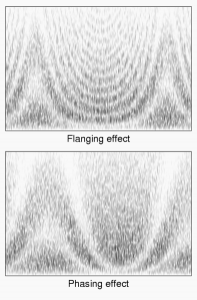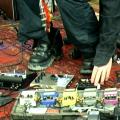 I recently just ordered a Boss BF-2 Flanger for a project. I already have an ancient DOD FX75 Flanger.. that sounds pretty crappy, so I wanted to get this older Boss BF-2 which I’ve been hearing good things. The bottom line, I have used a flanger in about 20 years. Never been to big on modulation in general. There was a time in the late 90s I was playing a Phase 100, but that’s really about it.
I recently just ordered a Boss BF-2 Flanger for a project. I already have an ancient DOD FX75 Flanger.. that sounds pretty crappy, so I wanted to get this older Boss BF-2 which I’ve been hearing good things. The bottom line, I have used a flanger in about 20 years. Never been to big on modulation in general. There was a time in the late 90s I was playing a Phase 100, but that’s really about it.
While I was messing around with the DOD FX75 flanger, I wanted to learn more about ‘flanging’ so did a little digging. When I hear a flanger vs. phaser, they both appear to sound similar. The flanger definitely has more of a metallic harmonic as it sweeps and the phaser has a deeper richer sweep. But what is it all about??
While doing my research I was pretty impressed what I found.. specifically the history of the flanger. The term ‘flang’ references the tape reel’s rim. The original technique of ‘flanging’ was to send a signal to two tapes and slowing down one tape so it becomes out of sync. The engineer operating the tape reels would literally put a finger on the reels to produce the sweeping effect.
This is where a flanger and phaser differs. The reference pages I was reading would use a ‘comb’ analogy. Basically a phaser uses the dual signal similar to the flanger but when combined it would go in and out of phase.. creating peaks and valleys that do not occur in harmonic series. So the comb comparison… flanger has evenly spaced comb filter spacing with even spacing where a phaser has un-even spacing.
I also thought the origin of the flanger was really cool. Apparently it was first used by Ken Townsend of Abbey Road studio in 1966. John Lennon of the Beatles as tired of re-recording dual vocal tracks and wanted a way to double track the vocals without actually singing the parts. Ken Townsend then did the double track with flang. John Lennon apparently coined the phrase ‘flanging’ while explaining it to George Martin.. and referred to it as ‘Ken’s Flanger’.
The first Beatles song double tracked with the flanger was “Tomorrow Never Knows” from Revolver.
The best thorough article I found was at Wikipedia.
Sorry about going on a little nerd tangent, but I thought it was interesting… and maybe you will too!



